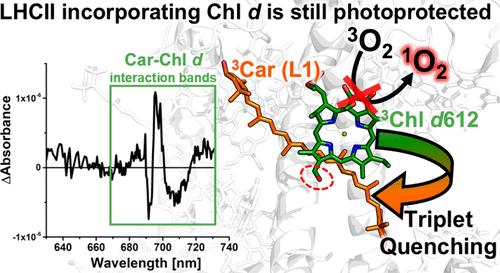含有叶绿素d的远红吸收LHCII保留了光保护性类胡萝卜素三重态-三重态能量传递途径
IF 4.6
2区 化学
Q2 CHEMISTRY, PHYSICAL
引用次数: 0
摘要
叶绿素d (Chl d)可以成功地引入到重组的LHCII中,并且对配合物内的能量平衡过程干扰最小,从而促进植物光收集配合物(lhc)的发展,增强了远红色光谱的光吸收能力。在这项研究中,我们研究了Chl d的引入是否会影响LHCII保护自身免受光氧化的能力,这是成功利用修饰配合物延长植物光收获的关键。本研究将Chl d加入到LHCII的单体单元Lhcb1中,利用时间分辨电子顺磁共振(TR-EPR)和光学探测磁共振(ODMR)研究了Chl三重态被类胡萝卜素猝灭。我们还对去掉Chl 612的LHCII A2突变体进行了表征,以帮助确定用Chl d重组的Lhcb1复合物上的三重态猝灭位点。我们发现,含有Chl d的远红吸收LHCII保持了光保护过程的效率。本文章由计算机程序翻译,如有差异,请以英文原文为准。

Far-Red Absorbing LHCII Incorporating Chlorophyll d Preserves Photoprotective Carotenoid Triplet–Triplet Energy Transfer Pathways
Chlorophyll d (Chl d) can be successfully introduced in reconstituted LHCII with minimal interference with the energy equilibration processes within the complex, thereby facilitating the development of plant light-harvesting complexes (LHCs) with enhanced capabilities for light absorption in the far-red spectrum. In this study, we address whether Chl d introduction affects LHCII’s ability to protect itself from photo-oxidation, a crucial point for successfully exploiting modified complexes to extend light harvesting in plants. Here we focus on incorporating Chl d into Lhcb1 (the monomeric unit of LHCII), specifically studying the Chl triplet quenching by carotenoids using time-resolved electron paramagnetic resonance (TR-EPR) and optically detected magnetic resonance (ODMR). We also characterize the A2 mutant of LHCII, in which the Chl 612 is removed, to assist in determining the triplet quenching sites on the Lhcb1 complex reconstituted with Chl d. We found that far-red absorbing LHCII incorporating Chl d maintains the efficiency of the photoprotective process.
求助全文
通过发布文献求助,成功后即可免费获取论文全文。
去求助
来源期刊

The Journal of Physical Chemistry Letters
CHEMISTRY, PHYSICAL-NANOSCIENCE & NANOTECHNOLOGY
CiteScore
9.60
自引率
7.00%
发文量
1519
审稿时长
1.6 months
期刊介绍:
The Journal of Physical Chemistry (JPC) Letters is devoted to reporting new and original experimental and theoretical basic research of interest to physical chemists, biophysical chemists, chemical physicists, physicists, material scientists, and engineers. An important criterion for acceptance is that the paper reports a significant scientific advance and/or physical insight such that rapid publication is essential. Two issues of JPC Letters are published each month.
 求助内容:
求助内容: 应助结果提醒方式:
应助结果提醒方式:


